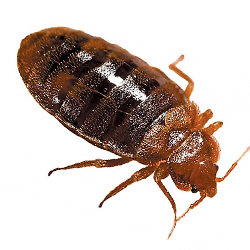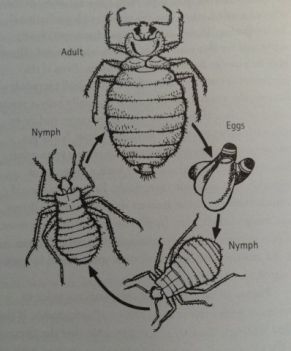
Life cycle and habits
Bed bugs have a gradual metamorphosis. Females must have a blood meal for protein prior to egg-laying. Eggs are stuck to surfaces with up to ten or more in a batch, the site for egg-laying chosen by the female usually includes cracks and crevices in and around furniture that are within close proximity to the sleeping area of the hosts. In an infested bedroom all the cracks and crevices are suitable areas for egg laying. The female may lay 200-500 eggs in her life time. Eggs can hatch within 7-30 days, and the nymphs need at least one blood meal between moults. Typically bed bug nymphs will go through around five moults before reaching adulthood. The life cycle of bedbugs can be short, about 45 days, but also can be up to a year or more, in more favourable condition. Adults can survive several months without a blood meal.
Habits
Males, females and nymphs are all bloodsuckers. During daylight hours they are spent hiding in cracks and crevices around to the bed. The temperature of a host will help in locating a blood meal; bed bugs will usually visit their host during the night. After a meal, they will return to their hiding places, where they may be found closely grouped together. Their most important host is humans, but in some cases bats, cats and other animals may serve for feeding.
Bed bugs as a pest
A sign of bed bugs in premises can be detected by the irritation caused to sleepers, blood spots on sheet can be a tell tale sign of activity. In infested premises, activity of live bugs hiding in cracks and crevices in furniture, behind skirting boards and among books or in bedding will be evident. When bed bugs bite their victim’s saliva with anticoagulant properties are injected. Bed bugs will test bite first which can result in a line of bites, some people don’t feel the bites and no allergic reaction is visible.

Life cycle of the bed bug










































